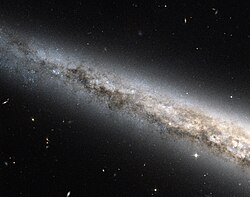Caldwell 38 - 2
These observations were taken to search for large groupings of old stars, known as globular clusters, in Caldwell 38. Seeing the Needle galaxy edge-on provides an excellent opportunity to explore globular star clusters. While most of a spiral galaxy’s stars lie within a relatively flat plane, globular clusters tend to be sparsely distributed all around the galaxy, surrounding it like a diffuse shell. When seen face-on, a galaxy’s globular clusters easily get lost in the mix; when a galaxy is seen edge-on, however, these clusters stand out.
By conducting a survey of globular clusters in several edge-on spiral galaxies, scientists have been able to study how these clusters form and evolve. Their results seem to indicate that globular clusters form with a very low metal content, but then their metallicity grows over time through subsequent mergers with other globular clusters.
The Needle galaxy was discovered by astronomer William Herschel in 1785 and is also cataloged as NGC 4565. It is about 40 million light-years away toward the constellation Coma Berenices. The galaxy is best viewed in the spring from the Northern Hemisphere (autumn from the Southern Hemisphere), and with a magnitude of 9.6 it is fairly easy to spot even with a small telescope. With larger telescopes, a prominent dark lane can be seen crossing the galaxy’s core.
For more information about Hubble’s observations of Caldwell 38, see:
https://www.spacetelescope.org/images/potw1228a/
Credits: NASA, ESA and K. Ashman (University of Missouri); Processing: Gladys Kober (NASA/Catholic University of America)
For Hubble's Caldwell catalog site and information on how to find these objects in the night sky, visit:
www.nasa.gov/content/goddard/hubble-s-caldwell-catalogRelevante Bilder
Relevante Artikel
NGC 4565NGC 4565 ist eine helle Spiralgalaxie im Sternbild Haar der Berenike am Nordhimmel. Weil von der Erde aus nur die schmale Seite der scheibenförmigen Galaxie zu sehen ist, wird sie in Anlehnung an diese dünne langgezogene Erscheinung auch als Nadelgalaxie bezeichnet. Ihre Entfernung beträgt circa 57 Millionen Lichtjahre und ihre Größe über 100.000 Lichtjahre. Die Galaxie ist eine der hellsten in der Coma I Galaxy Cloud, einer Ansammlung von Galaxien vor dem Coma-Galaxienhaufen. Möglicherweise bildet NGC 4565 darin sogar eine eigene Galaxiengruppe. In unmittelbarer Nähe von NGC 4565 befindet sich die Galaxie IC 3571. .. weiterlesen









